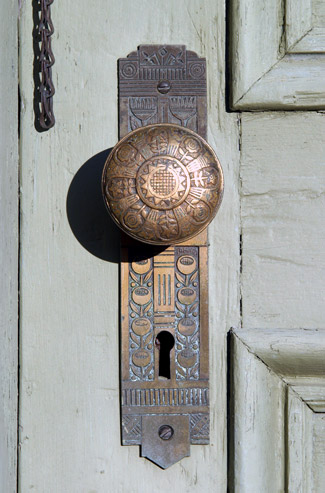The Doubling Point Range Lights (also known as the Kennebec River Range Lights) are located on Arrowsic Island at an important point in the Kennebec River. The lights are positioned at the end of a long, straight section of the river, and when mariners keep the two lights positioned one above the other, they are certain to be in the center of the channel. As a vessel coming upstream nears the lights, the river makes a 90° turn to the west, and then after a half mile another 90° to resume its course north. The Doubling Point Lighthouse marks the entrance to this tricky double bend in the river for vessels coming downstream.
The Annual Report of the Light House Board for 1892 announced the plans for the lights to mark the S-turn in the river: “At Doubling Point a red lens-lantern light, showing up and down the river, with a fog bell, and one-half mile east of the point, white range lights, not less than 500 feet apart, to mark the channel from Ram Island to Fiddlers Reach, at an estimated cost of $6,300.”
|
In 1912, the Ransom B. Fuller, a passenger steamer that operated between Boston and Bath, ran aground in foggy conditions just west of the Doubling Point Range Lights. The following year, a 1,200-pound fog bell was installed in a pyramid-shaped wooden tower near the site of the mishap to prevent similar occurrences. The tower is known as the Fiddler’s Reach fog signal. The Coast Guard removed the bell in 1972, and it is now on display at the Coast Guard Academy in New London, Connecticut.
The sharp bend in the river where the Doubling Point Range Lights are located can be very difficult for ships over 600 feet in length to navigate safely. Newly commissioned vessels leaving nearby Bath Iron Works often fall into this category, and passage through the area is a good first test for a ship’s rudders, not to mention the pilot’s skills.
One of the best-known keepers at the Range Lights was a retired deep sea skipper named Captain Harry L. Nye, who retired from the sea in the 1920s to become a lighthouse keeper, first at Seguin Point and then at Doubling Point. During his tenure, Nye rescued a number of boats that became stranded on the rocks near the lights.
|
Keeper H.L. Kilton was profiled in an article in the August 1948 issue of the Maine Coast Fisherman. The article stated: “Mr. Kilton lives, with his wife, at the Range Lights dwelling, the Doubling Point dwellings having been sold off some years ago. From there he attends to the two octagonal towers known as the range lights, at the lower end of Fiddler’s Reach in the Kennebec. Up the reach some 1075 feet and reached by two bridges on a path along the ledges is the Fiddler’s Reach fog signal, and at the upper end of the reach, a half mile from the dwelling is the Doubling Point lighthouse and bell.”
“Mr. Kilton has been on the station for three years, being a civilian keeper, and thoroughly enjoys it. The whole place was in apple-pie order with a neatly-cut lawn sloping off to an eye-catching view down the Kennebec. He doesn’t seem to be worried about slogging over to Fiddler’s Reach fog signal to wind his bell every four hours in fog and snow. As for the trip to Doubling Point when things go wrong in the winter - he snowshoes.”
“Although situated on Arrowsic Island and within reach of power lines, the station generates its own electricity with an 11 volt Kohler power system charging into a bank of batteries.”
Dan and Karen McLean first met in 1978 when they were both serving in the Coast Guard at Gloucester, MA. Two years later, they married, which meant they could no longer serve in the same unit. Dan left the Coast Guard in 1980, and Karen was going to do the same when her four-year term ended in 1982. However, the Coast Guard was reluctant to see her leave and offered her the Doubling Point Range Lights, where she would live and oversee the range lights as well as the lights and fog signals at Doubling Point and Squirrel Point.
The McLeans relocated to the station in February 1982. Getting to Squirrel Point was no simple chore, involving a short drive and a one-mile hike. In winter, the couple often used cross-country skis to reach the station. In 1984, Dan re-enlisted in the Coast Guard and was assigned to Station Boothbay Harbor. Two children were born to the McLeans while Karen was in charge of the station, then in 1987, Dan took over as officer-in-charge and Karen was assigned to Group South Portland.
In 1998, under the Maine Lights Program, the Doubling Point Range Lights became the property of a nonprofit group called The Range Light Keepers. The group is working to restore the fog bell tower and replace the bell and the "clockworks" that drove the striker. The Coast Guard has provided a bell, similar to the one used at the tower, that will be eventually be hung from the new bell beam. In the meantime, the bell is displayed at the Arrowsic Town Hall





No comments:
Post a Comment